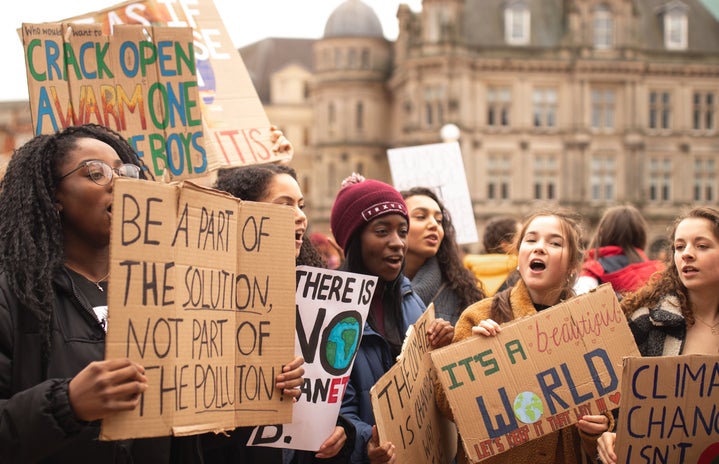As the 2021 United Nations Climate Change Conference, also known as COP26, comes to a close in Glasgow, Scotland, many activists highlight the continued disparities in gender representation on the main stage.
COP26 is one of the world’s largest climate change conferences with 197 participating member countries and 12 days filled with climate change negotiations, discussions and panels from policy-makers and experts. This year’s conference was especially important as the 2020 conference was cancelled due to COVID-19, and the timeframe for meeting the Paris target of limiting global temperature rise to 1.5 C is becoming increasingly slim.
However, many feminist activists are calling out the climate conference on the lack of women in senior management roles and the all-around representation for the events.
Founded in 2020 in response to the mere 15% of women on the UK COP26 Leadership Team, SHE Changes Climate is a campaign aimed at bringing diversity, inclusivity, transparency and accountability to the COP negotiations. #5050Vision is the campaign’s current mission which is largely focused on having 50 per cent of diverse women representation at the top levels of negotiations at COP26 and all subsequent climate conferences in the future.
In Dec. 2020, SHE Changes Climate created an open letter addressed to the UK Government calling for greater transparency and accountability on male/female parity for the COP26 leadership team. The letter garnered support from over 450 male and female environmental leaders and led to various talks with COP26 members. Despite all of this, the UK COP26 leadership team still only had 2 women out of 12 on the leadership team.
Other feminist activists share the same vision that women’s representation at the climate conference is imperative to the outcomes of the event. Malala Yousafzai spoke on the connection between climate change and girls’ education at a panel on Nov. 5. Yousafzai’s non-profit organization, the Malala Fund, conducted a report that concluded that four million girls from low-income and lower-middle-income countries will be prevented from completing their education in 2021 due to climate-related events. If these current trends continue, the report estimates that 12.5 million girls will be prevented from completing their education each year by 2025.
Activists are most concerned about disparities in women’s representation as it indicates that there will be disparities in climate solutions. According to UN figures, 80 per cent of people displaced by climate change are women. In developing countries, the gender-based imbalance in household activities also highlights the negative impact of climate change. Women, especially Indigenous, Black, brown, non-binary, disabled, migrant and women from other marginalized groups, are all-around disproportionately affected by climate change. Since women are so greatly impacted, activists argue that it makes the most sense to include them in finding adequate solutions.
However, women’s representation is more than just adding women to the mix and hoping their presence will breed impactful and transformative results. Women’s representation is intended for creating actual change from within. SHE Changes Climate explains that integrating women into talks allows for representation of their gender as part of their COP delegation, in turn creating truly representative leadership teams.
“When it comes to climate change, being representative isn’t about looking good, it’s about setting a good example and doing the best job possible. Not just for the nations being represented, but for every single one of their citizens.”
SHE Changes Climate
Including women in major discussions has already reaped many benefits on the international stage. Research shows that including women in climate talks leads to more stringent climate change policies. In terms of the pandemic, a 2020 study found that women-led countries experienced six times fewer deaths than their counterparts. Another study shows that since women, especially in developing countries, are often the key users of natural resources, they are more familiar with developing innovative solutions that can help fight climate change.
What is currently being done to address this issue?
Women’s representation has been a long-winded battle on the world stage. Canada released a Feminist International Assistance Policy (FIAP) in 2017, which is aimed at using a human rights approach to address six key target areas. The fourth action area in this framework addresses environment and climate change through a feminist lens.
Some criticism from the assistance foreign policy highlights how it lacks real transformative potential. However, addressing the inequities and ramifications that exist in environmental issues is a positive step in the right direction.
As for COP26, on Nov. 2, a statement recognizing the disproportionate impact of climate change on women and girls was launched following a panel discussion. Jointly sponsored by the Scottish Government and UN Women, the statement remains open for signatures from international leaders until the 66th meeting of the Commission on the Status of Women being held in March 2022.
In addition, Nov. 9 was set aside as Gender Day and is intended to “recognize and celebrate gender equality and the empowerment of women and girls in climate policy and action.”
Although inequities are being acknowledged and minor additions are being made, gender equity does not just end with the inclusion of women. Continued representation and development, as well as a clear acknowledgement of data and continued activism, can help ensure transformative change is being made by all fronts.


